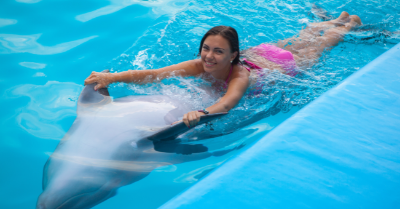
You can reduce the chances of water entering your mouth by using the correct snorkel. What is the difference between a dry and semi-dry snorkel?
Having salty water from the ocean enter your mouth is probably more common than expected. Using the correct snorkel can help you minimize the chances of swallowing awful tasting water.
The major difference between a dry and semi-dry snorkel is the float valve located on the open end of the tube. This valve is found on the dry snorkel, and it prevents water from entering the tube when submerged below the water surface.
Both dry and semi-dry snorkels are excellent at keeping water out of your breathing tube. But they both have a different purpose, and every snorkeler has their preference.
Snorkeling experts think that dry snorkels, which have a float valve to prevent the tube from filling with water, are better suited to newbies and children learning to snorkel. With dry snorkels, you don't have to worry about clearing the tube of water repeatedly. On the other hand, semi-dry snorkels are preferred by seasoned snorkelers and scuba divers due to the less drag and annoying buoyancy they offer.
The Dry Snorkel
Dry snorkels have covers and a unique mechanism at the open end of the tube that can prevent water from entering the snorkel even when it is submerged in the water. A dry snorkel ensures a minimum amount of water in the tube, making them ideal for newbie snorkelers.
Dry snorkels allow you to enjoy your snorkeling session more without worrying about filling your snorkel with water or how to clear water from your snorkel. This prevents random panic episodes, which can be triggered by being unable to breathe due to water in the tube.
How Does A Dry Snorkel Work?
Do you know that a toilet and a dry snorkel have something in common? It is called a float valve. As water fills up the flush tank, a floating bob rises. This bob is connected to a valve. The valve closes when the water has reached the desired level, preventing more water from flowing into the tank.
Dry snorkels are also equipped with a float valve on the open end of the tube. When the open end is submerged below the water surface, the float rises, causing the top end of the snorkel to seal shut. This prevents any water from entering the snorkel. But it also stops any air from entering or leaving the tube.
Most dry snorkels are also equipped with a splash guard and a purge valve. The splash guard ensures that most splashes or choppy water waves are diverted away from the tube. The purge valve allows you to remove water from the snorkel by exhaling into it effortlessly.
Advantages of Dry Snorkels
Minimum Water in Tube
As the name implies, a dry snorkel is designed to remain dry from the inside for the most part. It ensures minimum water enters the tube, which can be quickly removed through the purge valve.
However, this does not mean you will be sealed away from the water. It is inevitable that you will have some water enter your mouth regardless of the snorkel you use. But dry snorkels significantly reduce the chances of letting the water enter the mouth. They can be used by beginners, and children, as they will reduce the chances of choking, panic, or breathing challenges.
Longer Snorkeling Sessions
When you don't have to waste your energy clearing water out of a snorkel after every few moments, you can use that energy to prolong your snorkeling session. Your session will be more enjoyable as you focus on the underwater views and don't have to worry about choking or panicking when you cannot breathe.
You can continue below the water's surface for as long as your body can endure without having to surface repeatedly. This minimizes the chances of you missing out on any action that may be happening below the water surface.
Disadvantages of Dry Snorkels
Sticking Float Valve
The float valve atop the tube can sometimes get stuck in a closed position. This will make you feel like you cannot breathe through the snorkel because it is sealed shut. The first thing to do in such a case is not to panic. A stuck float valve is much more common than you think.
All you have to do is reach to the top of the snorkel and give it a little tap. You will get used to this with experience, and you will be able to reset the valve without even having to think about it.
The Floating Bob Can Be Annoying
The floating bob makes a dry snorkel more buoyant than other snorkels. It can take some time to get used to. The added buoyancy causes the snorkel to bob around more when submerged underwater; this can be annoying.
But these snorkels allow you to snorkel for longer, and the added duration to the snorkeling session far outweighs this advantage. They are also used by beginners who do not have much experience with different types of snorkels, so they are unable to tell the difference.
The Semi-Dry Snorkel
As the name implies, a semi-dry snorkel has components that keep water out, but not as much as a dry snorkel. It resists splashes and choppy water and prevents it from entering the tube. But if you were to submerge it below the water's surface, a semi-dry snorkel will get filled with water and need to be emptied out.
Semi-dry snorkels are most commonly used by scuba divers who want to preserve the air in their tanks when swimming near the surface and don't want to carry around the bobbing dry snorkel.
How Does A Semi-Dry Snorkel Work?
The semi-dry snorkel contains all the components of the dry snorkel except the float valve. This is the reason water fills the tube when it is submerged. Most semi-dry snorkels have a purge valve, which allows you to remove the water in the snorkel easily.
Advantages of Semi-Dry Snorkels
Splash Guard and Purge Valve
Semi-dry snorkels come with a splash guard and a purge valve. As discussed above, the splash guard ensures most splashes, whether due to choppy water or the snorkeler kicking and swimming, get diverted away from the open end of the tube.
The purge valve makes it easy to remove the water from the snorkel. All you have to do is exhale into the mouthpiece, and the air will force out the water through the purge valve.
Lightweight
Compared to dry snorkels, semi-dry snorkels are lighter and offer less drag. Since they do not have a floating bob, they have lower drag and resistance. They also do not bob up and down when submerged in the water. They are easier to carry along, which is helpful for scuba divers who use them only occasionally.
Disadvantages of Semi-Dry Snorkels
Require Extensive Clearing If Submerged
Since semi-dry snorkels lack a float valve, the tube gets filled with water when submerged below the water surface. You will need to clear the snorkel of water before using it again. You can use the purge valve, but a filled tube may require a blast clear or displacement clear technique.
Not The Best Option For Beginners or Children
Beginners or children can panic if water enters their mouths. Although semi-dry snorkels are good at keeping water out, they are not as efficient as dry snorkels. But if you know how to use the purge valve, you can quickly get rid of the water that enters your snorkel.
How Does A Purge Valve Work?
If a snorkel is equipped with a purge valve, any water that enters the tube gets collected in a particular area. This reduces the chances of the water reaching your mouth, especially if it is only a little.
When you blow into the tube with a mid-strength exhale, the purge valve opens up, and the air from your breath pushes the water out. The valve is designed to operate in one direction only. The water in the tube is pushed out along with the air you exhale. However, the valve prevents any water from flowing back into the tube.
A purge valve requires much less effort than attempting to blow the water out of the open end of the snorkel. Like with other skills related to snorkeling, with sufficient practice, you can get used to the purge valve and use it without even thinking about it with time.
About THE AUTHOR

Derek Fallon
Hi! I'm a marine biologist who has had the privilege of surfing, snorkeling,and diving all over the world. There's nothing better than catching a good wave, except for helping others become confident in their abilities. I love sharing my insights with those who want to learn. When I'm not giving surfing lessons I'm usually working on building my own small sailboat.
Read More About Derek Fallon










